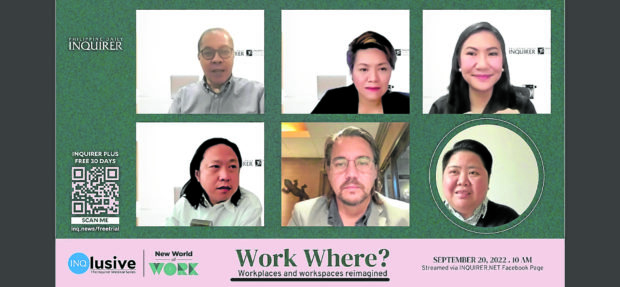New world of work

Catch a replay of this webinar via Inquirer Property’s Facebook page (https://www.facebook.com/INQ.Property/)
Companies must make their workplaces more flexible if they intend to enter the next normal with ease, said experts in a recently held INQlusive webinar titled, “Work Where? Workplaces and workspaces reimagined”.
“Work Where?” is the second in a three-part series titled, “New World of Work.” The episode, held in partnership with the United Architects of the Philippines (UAP) and its Professional Development Commission (PDC), gave design professionals a platform to share their thoughts on the workspaces suited for the post-pandemic era.
Such a discussion remains timely. Boardrooms are deciding on post-pandemic operations in the face of a workforce divided. The 2021 PhilCare Wellness Index revealed that 48.7 percent of Filipinos prefer the hybrid setup while 35 percent want to return to their offices. Sixteen percent meanwhile intend to keep working from home.
Failure to come to a solution amenable for everyone may lead to high and paralyzing turnovers and workers vacating their posts, feeling underserved or that they could do better. To dodge that, the speakers noted that work environments must offer options to employees, instead of imposing a mold.
The conversation is not new, explained Ar. Joel Luna, founder and principal of Joel Luna Planning and Design.
“But, during the pandemic, we were witness to how radically we had to transform the work environment,” he noted.
Luna pointed out that the ideas of thought leaders became the way forward—working outside the office and outside the 9-5 schedule. What has mattered and will matter beyond the pandemic nowadays are energy efficiency and increased outputs, and workplaces must transform for that.
Ar. Joan S. De Leon-Tabinas, executive director of UAP PDC, offered four possibilities for offices in presenting “return-to-office” strategies.
The first option is the office “as it was”—run as before but with health protocols and well-being in focus. For activity-based working strategies, employees “have no exact assigned task” and move between areas. A third route is the variety of work setting wherein offices act as social hubs. Finally, the satellite hub allows employees to stay in hubs closer to their homes.
There is no one-size-fits-all solution, noted Ar. Angelo Mañosa, CEO of Mañosa and Co. Inc. In deciding how the next-normal office should look, companies must first examine the limitations inherent to the industry they work in, explaining that hybrid or work-from-home arrangements would be impossible for certain fields such as manufacturing, agricultural, hospitality and medical.
Beyond this, leaders must find what makes their employees happy. After addressing the pain points, Mañosa said his firm found the workers being content with a hybrid setup. “I would say happy employees make for happier work environments,” he added.
Aidea Inc. interior designer Rio Siasar introduced data-based musts for the next-normal office. With one in four workers concerned about air quality and protocols, she advocated designs geared toward safety. The clamor for access to resources and ease of working means offices must be designed for productivity. Because people want to interact and share goals, spaces must be both flexible and inspiring.
Ar. John Ian Lee Fulgar, principal of Fulgar Architects, agreed.
“I think the workplace should be less rectilinear, and have softer visuals or the coffeeshop vibe that employees love nowadays… The social aspect is very important. We cannot just rely on pararelationships, and people are people,” he said.
Fulgar shared that micro offices, where the traditional headquarters are divided into smaller venues, could be a viable model. Whatever directions decision-makers take, however, the office should be built with the mindset that COVID-19 “might happen again” and should be based on sustainability principles.
“We should really view healthy environments as synonymous with sustainable environments, right? They’re essentially one and the same,” said Luna. “In the end, the objectives of all companies are the same. We want to remain competitive, to deliver our best work and, therefore, [we must] make sure that our people are always motivated, that we look after their welfare, that they are inspired.”
